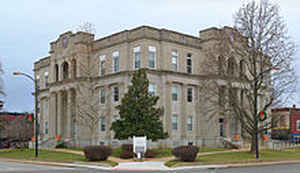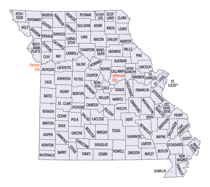Missouri Counties
Missouri has one hundred and fourteen counties and one independent city. St. Louis City is separate from St. Louis County and is referred to as a "city not within a county." Following the Louisiana Purchase and the admittance of Louisiana into the United States in 1812, five counties were formed out of the Missouri Territory at the first general assembly. Most subsequent counties were apportioned from these five original counties.St. Francois County, Missouri
St. Francois County Education, Geography, and History
St. Francois County /ˌseɪnt ˈfrænsɨs/ is a county located in the Lead Belt region in the state of Missouri. Based on the 2010 census, the
population was 65,359. The largest city and county seat is Farmington. The county was officially organized on December 19, 1821. It was named
after the St. Francis River. The origin of the river's name is unclear. It might refer to St. Francis of Assisi. Another possibility is that
Jacques Marquette, a Jesuit who explored the region in 1673, named the river for the Jesuit missionary Francis Xavier. Marquette had spent
some time at the mission of St. Francois Xavier before his voyage and, as a Jesuit, was unlikely to have given the river a name honoring the
Franciscans.
St. Francois County comprises the Farmington, MO Micropolitan Statistical Area, which is also included in the St. Louis-St.
Charles-Farmington, MO-IL Combined Statistical Area.
Etymology - Origin of St. Francois County Name
Named for the St. Francois River. A large river, whose headwaters are formed by First, Second, and Dry creeks of Iron and St. Francois counties, flowing through Wayne and Madison counties, forming the western boundaries for Stoddard and Dunklin counties, and finally emptying into the Mississippi River near Helena, Arkansas. It was known to the Indians as Cholohollay meaning "smoky-water." Eaton says it was named by early settlers or explorers for the patron saint of their order. This would be St. Francis of Assisi. However, none of the prominent early explorers were of the Franciscan order, or at least none who descended to the mouth of the St. Francois River. Hennepin was the only Franciscan among the prominent explorers, and he named the St. Francois River in Michigan, now known as the Rum River, so it is not likely that he also named this river; nor did he descend south as far as the St. Francois. De Soto mentions a river answering the description of St. Francois River, but he did not mention its name. Marquette reached a point near where the river empties into the Mississippi River in 1673, and possibly he named it, as he had spent some time at the mission of St. Francois Xavier before starting on this trip. St. Francis Xavier (1506-1552) was a Jesuit missionary, like Marquette, and a friend of Loyola, the founder of the Jesuit Society. The river was first used in business proceedings in the grant of New Madrid to Colonel Morgan in 1787. The spelling St. Francis is sometimes seen on recent maps. (Buel, 240-241; Houck (1908) I, 16- 17, quoting from Silliman's JOURNAL OF SCIENCE III: 25; MHR, XIII, 60; Miss Hamlett's thesis)
Source: Zimmer, Gertrude M. "Place Names Of Five Southeast Counties Of Missouri." M.A. thesis., University of
Missouri-Columbia, 1944.
Demographics:
County QuickFacts: CensusBureau Quick Facts
History of Saint Francois County
This county was formed out of parts of earlier Ste. Genevieve, Jefferson, and Washington counties. It was established by act of the legislature on December 17, 1821. Irregular in form, it is bounded on the north by Ste. Genevieve and Jefferson counties, on the south by Perry, Madison, and Iron counties, and on the west by Iron and Washington counties. So named from the river of the same name which runs almost entirely through it. (Conard (1901) V, 430; Miles, HIST. ST. FRANCOIS (1935) 3)
Source: Zimmer, Gertrude M. "Place Names Of Five Southeast Counties Of Missouri." M.A. thesis., University of Missouri-Columbia, 1944.
Geography: Land and Water
As reported by the Census Bureau, the county has a total area of 455 square miles (1,180 km2), of which 452 square miles (1,170 km2) is
land and 2.8 square miles (7.3 km2) (0.6%) is water.
The general surface of St. Francois County is hilly or undulating, but the extreme southern and northeastern corners are table lands
excellently adapted to fruit-culture and grazing purposes. The country around Farmington, and for several miles on either side of the St.
Francis River, is excellent land, well timbered and sufficiently undulating to render drainage unnecessary. It is well supplied with water
from never-failing springs and is drained by Blackwell and Rock Creeks, St. Francis River, Wolf and Back Creeks. Stono Mountain, embraced in
this section, is said to afford excellent sheep pasturage.
The northern portion of the county is drained northward by the Big River and its tributaries, including the Flat River, most often known
locally as "Flat River Creek."
The southwestern portion of the county, drained by Indian Creek, is exceedingly hilly. The central and northern section is drained by Big
River and its tributaries, Flat River, Davis Creek, Big Branch, Terre Bleu and Three Rivers. The name "Flat River" preserves the name of the
town of Flat River, which was dissolved in the formation of the city of Park Hills in 1994. The valleys of these streams are excellently
adapted to agricultural purposes, the cereals all doing well. On several of the steams mentioned, there are good mills, and many more
excellent sites having sufficient water power to run a mill the entire year.
The uplands are well timbered, yielding from 40 to 100 cords of wood to the acre. The timber consists of white, red and black oak, ash,
cherry, walnut, hickory, maple, gum, papaw and dogwood, with beach, sycamore and butternut on the bottoms. Cedar and pine are found in a few
localities on the uplands. The soil is generally a black loam. In the vicinity of Farmington, after passing through the first or top soil,
there is rich, red-clay subsoil. If these lands have a specialty, it is for grass. All kinds of grass grow luxuriantly, producing from 2 to 2
1/12 tons per acre, which readily markets at from $12 to $20 per ton. Blue grass, it is said by farmers from the blue grass region of
Kentucky, does nearly as well here as there, and as an evidence, it is found growing spontaneously in the woods, lawns, old fields and
meadows.
Neighboring Counties
Bordering counties are as follows:
- Jefferson County (north)
- Ste. Genevieve County (east)
- Perry County (southeast)
- Madison County (south)
- Iron County (southwest)
- Washington County (west)
Education
Of adults 25 years of age and older in St. Francois County, 72.4% possesses a high school diploma or higher while 10.2% holds a bachelor's degree or higher as their highest educational attainment.
Public schools
Bismarck R-V School District - Bismarck
Farmington R-VII School District - Farmington
North St. Francois County R-I School District - Bonne Terre
St. Francois County Central R-III School District - Park Hills
West St. Francois County R-IV School District - Leadwood
Private schools
St. Paul Lutheran School - Farmington - (PK-08) - Lutheran Church-Missouri Synod
St. Joseph School - Farmington - (K-08) - Roman Catholic
St. Joseph Elementary School - Bonne Terre - (PK-06) - Roman Catholic
Vocational-technical and other schools[edit]
Juvenile Detention Center - Farmington - (04-12)
Midwest Learning Center - Farmington - (04-12)
Unitec Career Center - Bonne Terre - (10-12)
Colleges and universities
Mineral Area College - Park Hills - A public, two-year community college.







